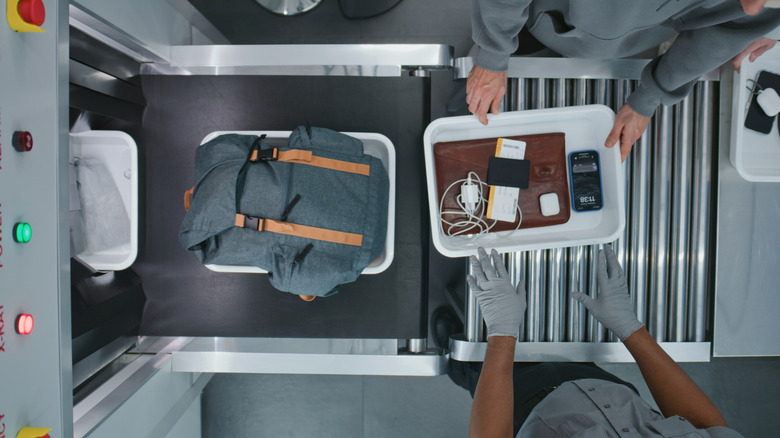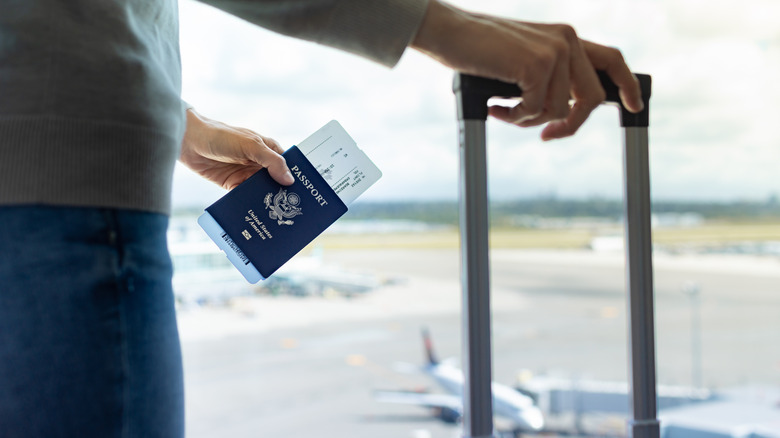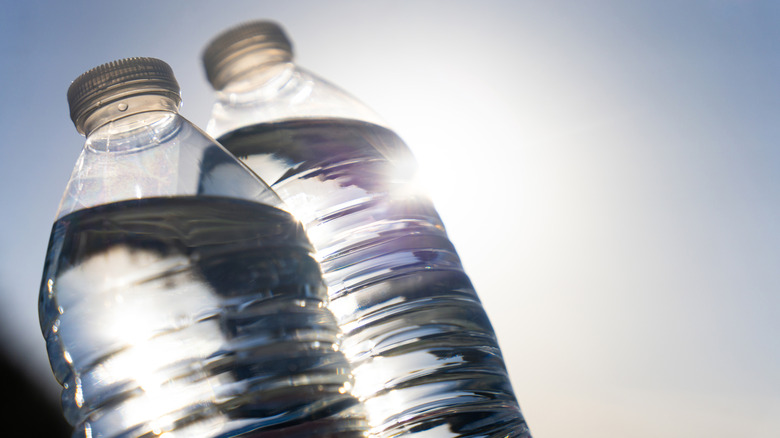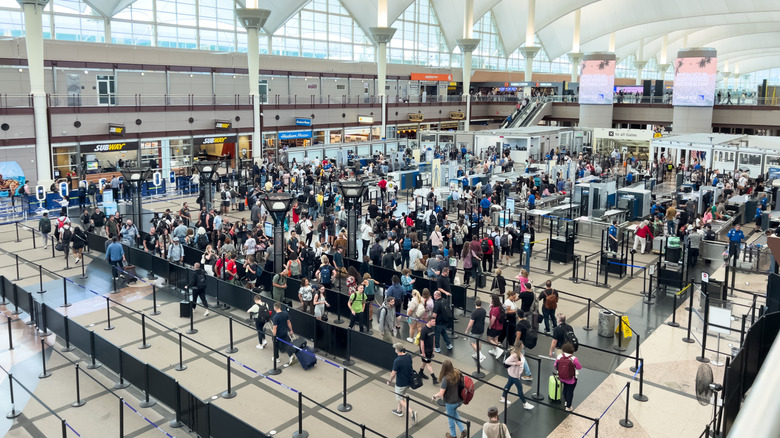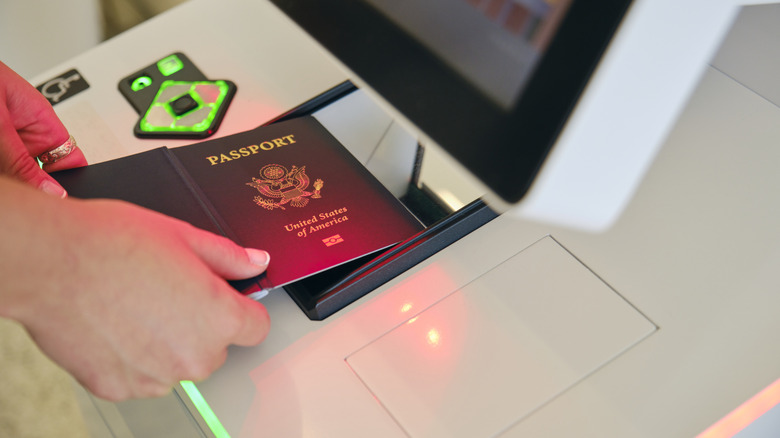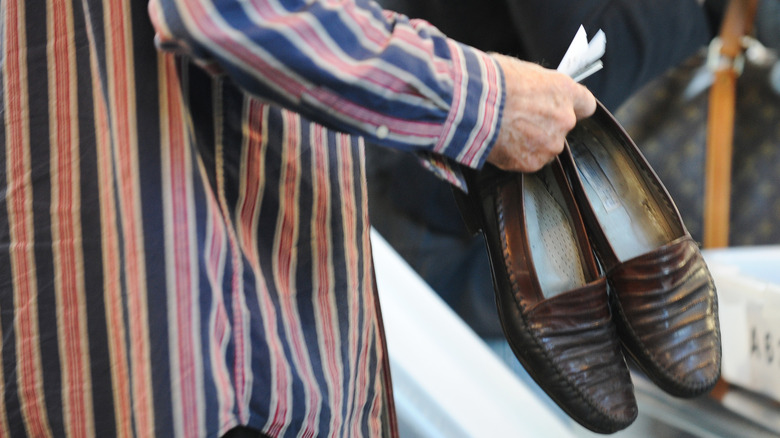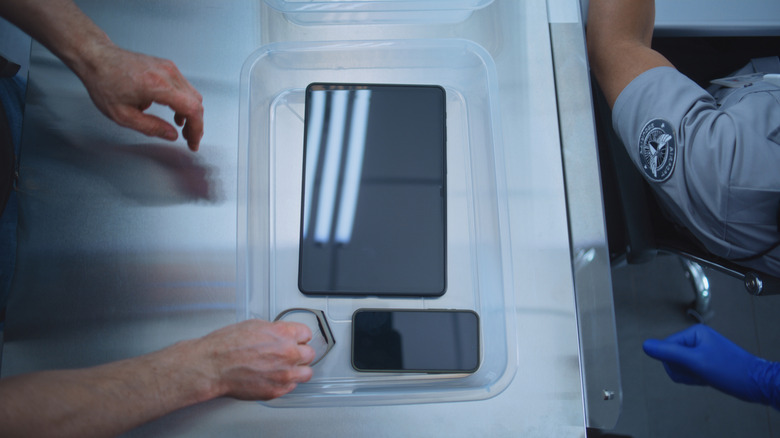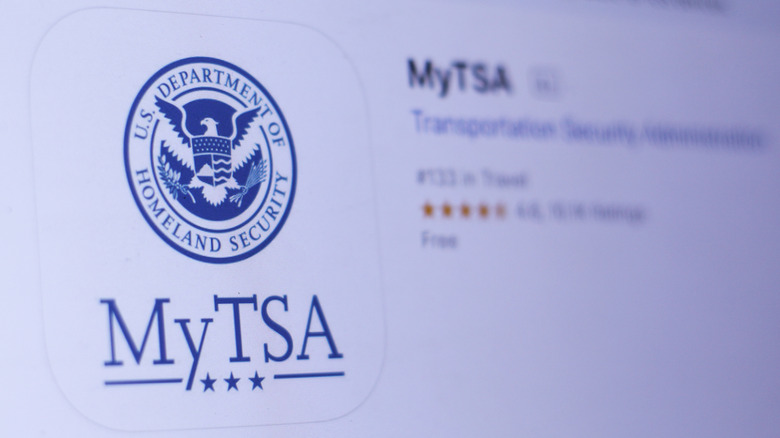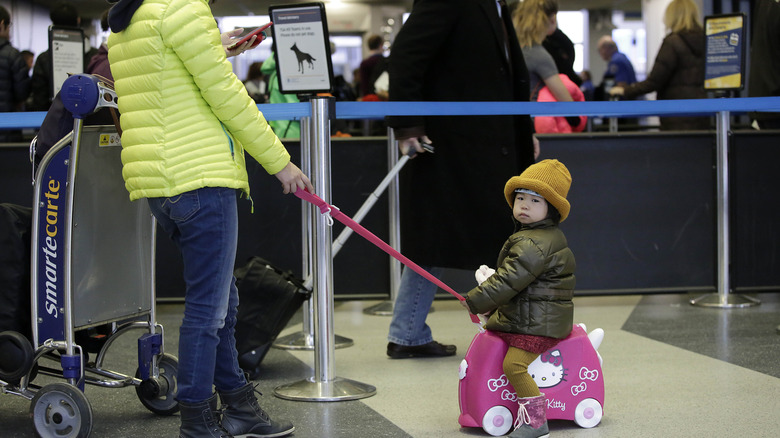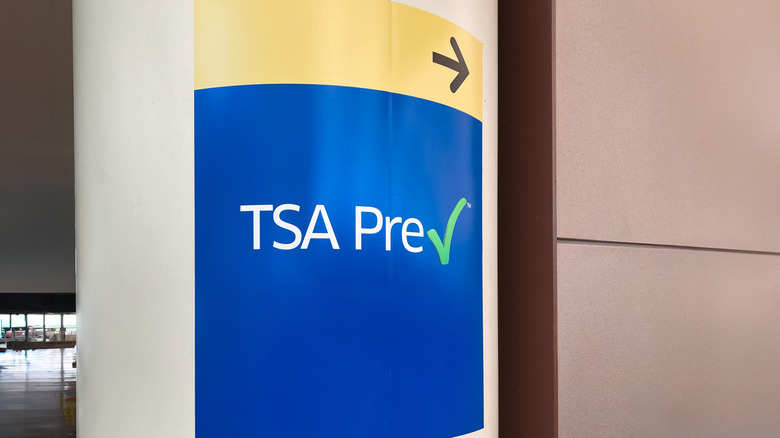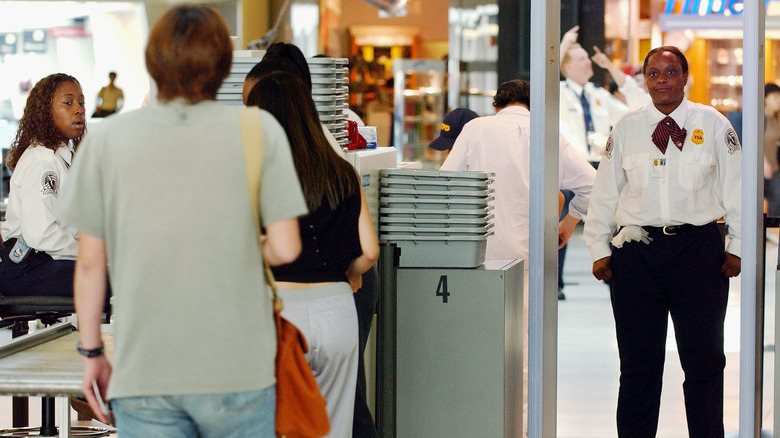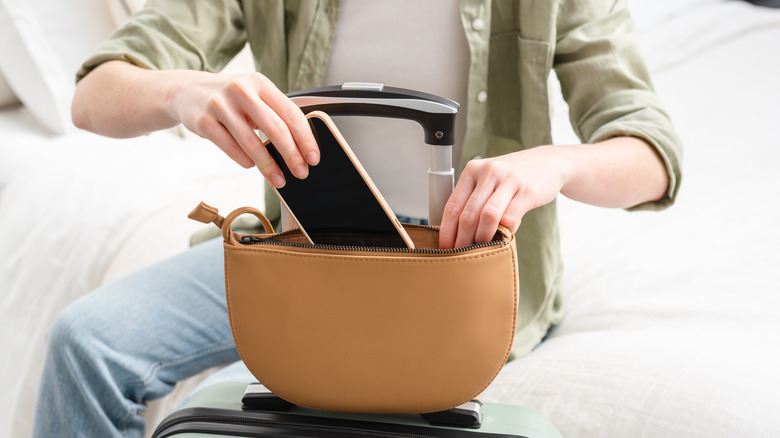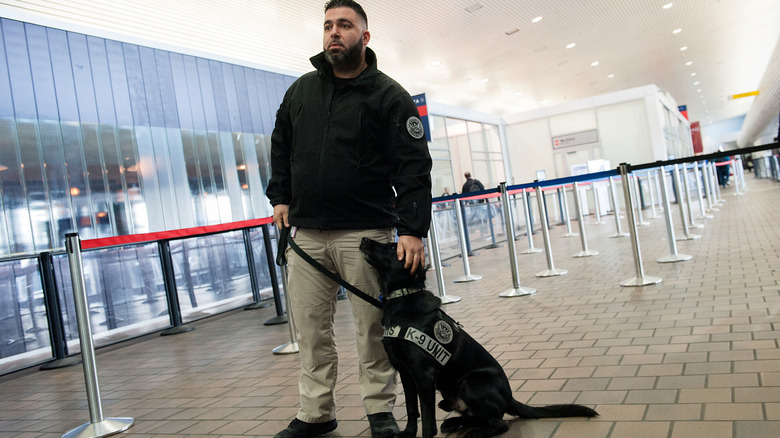12 Quintessential Airport Security 'Dos And Don'ts' Straight From TSA
Working your way through airport security often involves plenty of waiting and occasionally a few delays. Long lines can add significantly to the time it takes to get to your gate (still, think twice about picking the shortest line at airport security). But if you display one of the signs that TSA agents are looking for, you may get pulled aside for extra checks. Wearing baggy clothing and keeping your eyes on the ground are great ways to be targeted for additional scrutiny. Beyond the mannerisms that can spirit you through security or hold you up, TSA publishes its recommendations on how best to interact with this stage of the travel experience.
TSA's 12 things to do and avoid can help you navigate the security line with greater ease, taking the pressure off a sometimes stressful chokepoint. Unlike airport security secrets that easily fly under the radar, these crucial tips are published openly — and TSA hopes that you take notice of them. By following the basic structure of these suggested behaviors, you'll improve your journey through the security line.
1. Do: Match your ticketed name with the one on your ID document
First and foremost, when making an airline reservation, you'll have to provide some basic personal details. Your name is one of these important pieces of information, but there's more to this identifying feature than meets the eye. According to a 2022 survey published by YouGov, as many as one in four Americans routinely go by a name that is not on their birth certificate. In some instances, this may be drastically different, with a true nickname taking the place of the person's given one. In other cases, people go by initials or middle names as well as shortened versions of their birth names.
Regardless of the moniker you use daily, the name you enter when booking your flight needs to be the one that's on your ID. Whether you're traveling internationally or on a domestic route, you'll head through the security line and have your identification document checked against your ticket. If the names don't match (even in a Chris versus Christopher kind of manner), you'll experience at least a small delay in your travel plans. The name on your boarding pass should always match the document you hand to the TSA agent. If it doesn't, additional questions are sure to follow, and you may even miss your flight or be denied access to the terminal beyond the security checkpoint.
2. Don't bring water to the security line
If you bring a bottle of water to the security line, you'll have to dump the liquid or toss the entire bottle to progress through the checkpoint. This might not be a problem for someone carrying a disposable water bottle, but it can still slow things down for you and others. So, generally, it makes for a bad idea all around. However, things get particularly sticky with refillable water bottles. Most travelers won't be happy about the idea of parting with their reusable bottles, and the facilities may not be available to dump out the water. This can leave you in a tough spot.
The reality is that this problem is easy to avoid. Whether you're carrying a reusable bottle or a simple plastic alternative, make sure it's empty when you arrive at the security checkpoint. By doing this, you can just put the bottle into one of the bins and send it through the scanner. Then, on the other side of the checkpoint, you'll almost certainly be able to find a water fountain to fill up the bottle. Unfortunately, this is a step travelers often forget to take. While you're here, check out the bizarre item the TSA considers liquid.
3. Do: Prepare for security check while waiting in line
TSA suggests using your time wisely when standing in line. As you prepare to place your bags on the X-ray belt and move through the scanner, you'll need to take things out of your pockets and remove some items from your bag. You might have a hard time carrying your liquids bag or laptop as you make your way through the line. However, most travelers won't have difficulty removing their phone from their pocket alongside keys, change, and anything else they may be carrying. Placing these things in your bag and taking additional steps, like taking off your jacket and belt, can go a long way to speed up your transition from one side of the checkpoint to the other.
Taking things out of your pockets is particularly helpful. Doing this before you arrive at the scanners can prevent delays for you and others. It will also prevent additional security steps that may be more invasive, such as pat-downs.
4. Don't stick your ID or ticket in your mouth
As you proceed through the security line, you may be tempted to use your mouth as an additional item-holding tool. Holding on to your ID or boarding pass with your mouth seems like a harmless solution when you've got lots of other things going on. This is especially true considering your hands might be busy removing items from your pockets and holding a variety of additional objects. However, things look different from the perspective of the TSA agents on the other side of the desk.
These security agents interact with hundreds or even thousands of travelers throughout their day. And these interactions don't just include a conversation. With every traveler the TSA staff checks, they take their ID and boarding pass to inspect and run it under a scanner. This means that if you have been fumbling around with these documents in your mouth before interacting with a TSA agent, you'll be handing them remnants of your spit as you pass your documents across the counter. This is impolite. On the other hand, placing these documents in your mouth after you make your way through the security checkpoint potentially exposes you to the germs of countless other travelers.
5. Do: Wear shoes you can easily take off and put back on
The shoes you wear to the airport can play a significant role in your experience of moving through the security line. Shoes that are difficult to remove will slow you down as you work through this necessary hurdle between you and the gate. Instead, consider shoes that can be easily slipped off and put back on without much hassle. Opting for low-profile shoes like this can speed your movement through the security checkpoint, which is frequently something travelers prioritize in the experience.
However, it's worth noting that this won't always be the best course of action for your travel needs. Tan France's genius packing hacks include wearing your heaviest shoes when you board a plane to save space in your bag. You'll certainly experience a longer transit through the security line, but sometimes, this tradeoff is worth it. Even though TSA personnel would prefer you to wear shoes that can be quickly removed to speed things along for everyone in the security line, bucking the trend may be worth it in some circumstances. For instance, if you are planning on hiking challenging trails in U.S. national parks or just need more than one pair of shoes for some other reason on your trip, it might be best to wear your heaviest.
6. Don't put small, loose items directly on the X-ray belt
Suppose you only have a few small items to send through the scanner (perhaps you checked your bag and opted not to bring a carry-on). In that case, it might be tempting to just toss your phone, keys, and other loose items directly onto the X-ray belt. However, this is a bad idea, no matter the item. The conveyor belt that moves through the X-ray machine features a variety of small, moving parts. If you place loose items on it, there's a very good chance they may get lost in the machine. Instead, even if you're only carrying two or three small, loose items, place them in a bin, even if it seems like an overkill.
Not only do you run the risk of losing important items like your phone or house keys, but you can also negatively impact the scanning equipment. Because small items tend to move around when placed directly on moving belts, they can end up lodged in the equipment's internal components. The result can be a permanently lost item. Choosing to send your things through the machine like this can also break it, bringing a whole range of other problems into your life beyond the need to replace a pair of headphones or get a new key cut.
7. Do: Download the myTSA app
TSA notes that the myTSA app is a great source of information that can help you plan your day of travel. The app features a "What Can I Bring" informational section. This can be significantly valuable for travelers who may not know which items to check and which ones to put in a carry-on bag. The app also offers estimated wait times for the security checkpoints at your transit airport.
Downloading the app before your travel day and reviewing the information as you make and execute your packing list can be helpful in the planning phase. Rechecking as you prepare for the airport can streamline travel. Knowing what to expect in the security line before you leave for the airport can help you make decisions about how long you need to give yourself. This is especially true considering that the conventional wisdom of a three-hour airport arrival window isn't necessary (take "Airport Theory" with a grain of salt). This can give you the opportunity to stop for a meal or rush along to the airport and through to the boarding gate in line with the current conditions.
8. Don't put children or pets on the X-ray belt either
One of the critical don'ts that TSA highlights might come as a surprise. The security service recommends that travelers should avoid putting children or pets on the X-ray belt to be scanned. You might think that this isn't a problem that needs to be highlighted. However, it has happened before, and even though it's not something you'll frequently encounter, it will almost certainly be due to a lack of knowledge about how these scanning equipment work or through momentary bouts of forgetfulness.
Children and pets belong in the typical line in which travelers are evaluated by TSA personnel. If you're bringing a dog or cat, TSA staff will have a look at the pet while their carrying crate is sent through the X-ray machine. This is likely where the confusion stems. Children and pets often approach the security line while sitting on an accessory that will be put through the scanner. Children may be in strollers, and pets are often carried in crates. Both of these things will be sent through the X-ray machine, but the living, breathing user of these pieces of equipment shouldn't be.
9. Do: Utilize the TSA PreCheck program
One of the most valuable tools you can utilize for the TSA line is TSA PreCheck. The PreCheck program begins with standard ID verification tasks. You'll head into the airport for an interview and then be placed on the TSA pre-qualified traveler list. Once you've completed the PreCheck enrollment steps, you'll be able to line up and zip through TSA's faster lines, making your journey through the security checkpoint a rapid experience rather than a slog.
In addition, you'll be able to leave on your shoes, belt, and a light jacket if you're wearing one. The people who tend to enroll in the TSA PreCheck program are travelers who fly frequently. This means they are often highly attuned to the steps that must be taken to have their boarding pass checked and be on their way. Lining up here affords you the fastest check possible in many instances. If you enroll, you'll often find that your airport experience is far more streamlined and much less chaotic every time you fly.
10. Don't bring your gun to the security checkpoint
There are many things you should pack in a checked bag. Large liquid items, specialty gear like power tools, and more are prohibited in a carry-on bag. Guns are one more item you'll never be able to bring through a security checkpoint and carry onto the plane. Still, Atlanta's Hartsfield-Jackson International Airport has confiscated over 1,000 firearms in the last few years. Most travelers don't carry a firearm when they fly, but for those who do, there is a correct way to check a gun at the airport.
Naturally, the weapon must be checked, and if you forget you're carrying one, it can lead to severe delays and perhaps additional criminal or civil penalties. Even an honest mistake that sees a gun brought to the security line is treated with the utmost seriousness. TSA staff simply can't afford to take risks when it comes to weapons. If a gun is found, expect the security line to shut down and the carrier to be treated as a potentially dangerous individual.
If you bring a gun with you, it will need to be unloaded and placed in a locked container in your checked bag. There are a number of steps that must be taken to successfully navigate these requirements, including showing the container and its locking mechanism to the airline check-in agents. TSA offers specific guidance on how to appropriately achieve this, but the bottom line is that bringing a weapon in your carry-on is never the way to do it.
11. Do: Stick your phone in your bag rather than the security bin
TSA suggests placing your phone in your carry-on bag as you approach the security checkpoint. Doing this while standing in line can be an efficiency booster, but there is another reason to secure your phone in this way rather than tossing it in one of the security bins when you arrive at the scanning equipment. Among the many sneaky things airport staff aren't likely to tell you, there's one involving hygiene that many people don't notice.
If you spend even a moment thinking about it, the cleanliness of these security bins seems obvious. However, most people don't pay any mind to these ubiquitous sights in the airport security environment. Indeed, security bins are some of the dirtiest items you'll encounter in an airport. Countless hands have touched them, and you can't ever be certain that the person who grabbed the bin before you was not sick or had not sneezed into their hands before touching this nondescript gray container.
It's typically a good idea to bring hand sanitizer when interacting with heavily trafficked public environments like this. However, there's another step that can take your cleanliness just a bit further. Your phone is an object you touch numerous times every day, and it spends plenty of time near or on your face. Keeping it from making contact with this dirty bin is, therefore, an easy way to prioritize your health.
12. Don't joke about explosives, hijacking, or any other sinister plots
Finally, one thing that TSA is deadly serious about is a prohibition against threatening behavior, even as a joke. TSA staff are trained specifically to spot people who act strangely. They'll notice odd behaviors about you that may indicate a hidden agenda or nervousness. Sweating, talking profusely, or avoiding eye contact all suggest that a traveler may be hiding something, according to the TSA playbook on behavioral patterns. The stakes are high in an airport environment. One sinister actor slipping through the cracks can lead to hundreds of injuries or even fatalities. In the post-9/11 world, airport security takes every threat and insinuation of danger to be an active and imminent risk.
If you joke about having an explosive device, hijacking an airplane, or even casual physical violence while standing in the security line, you can expect to be pulled aside and questioned aggressively by TSA staff and police. Security staff at airports take these kinds of situations at their word, even if it's abundantly clear that a person may be joking around. They simply can't afford to get it wrong, so if you say something of this nature, you can expect to miss your flight and potentially even face legal consequences.
